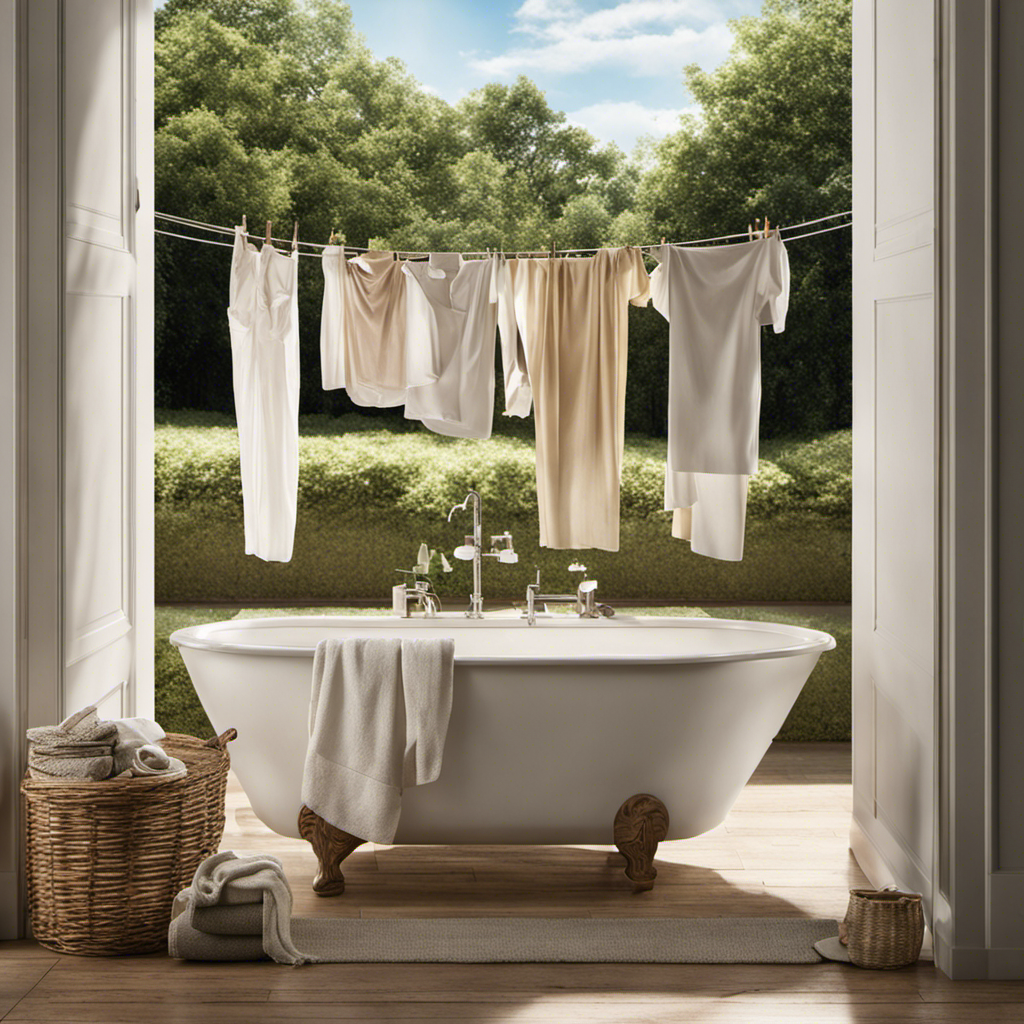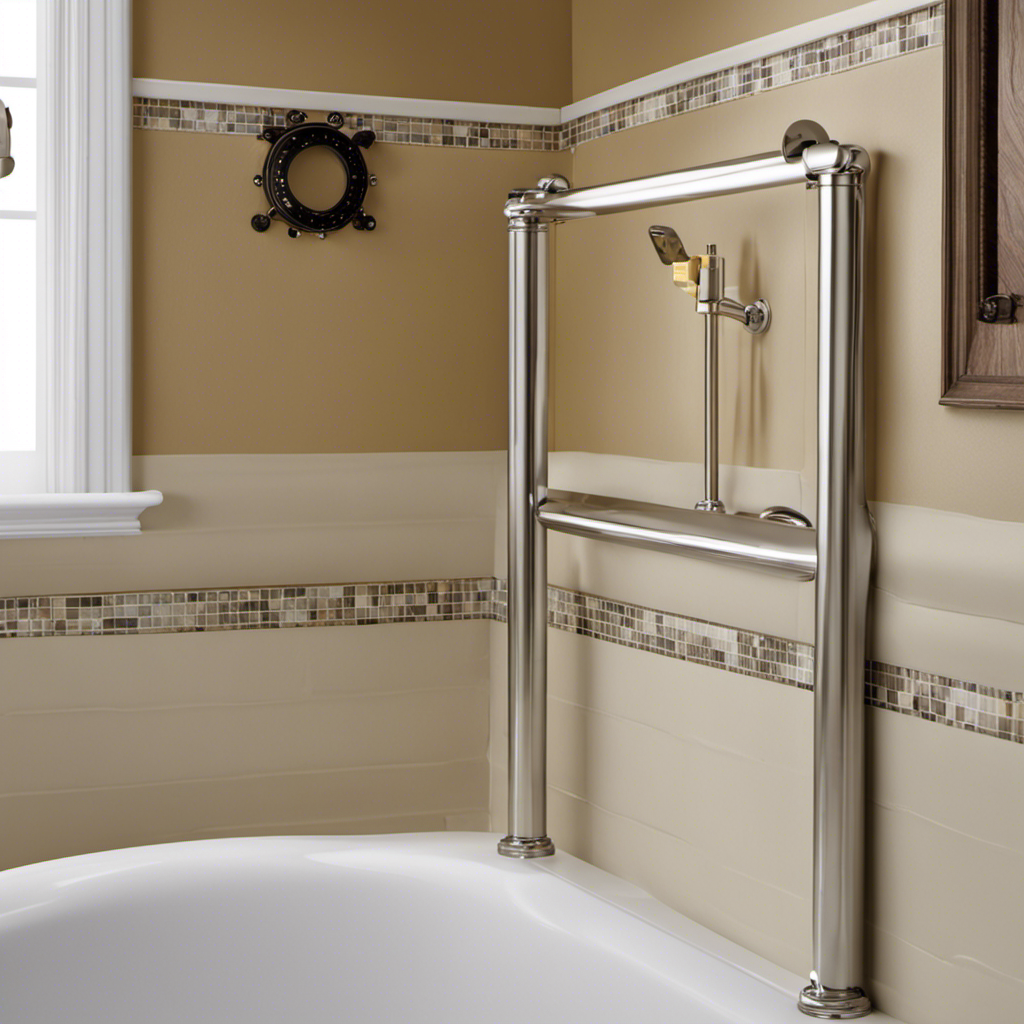As someone who has always believed in taking matters into my own hands, I’ve discovered an empowering and cost-effective way to keep my clothes clean and fresh – hand washing them in the bathtub!
In this guide, I’ll walk you through the step-by-step process of rejuvenating your garments with a personal touch. From gathering the necessary supplies to perfecting your hand washing technique for different fabrics, you’ll become a laundry expert in no time.
So, roll up your sleeves and let’s dive into the world of bathtub laundry!
Key Takeaways
- Gather all necessary supplies before starting the hand washing process, including a large basin or tub, laundry detergent or soap, a scrub brush or gentle sponge, and a bucket for collecting rinse water.
- Sort clothes by color and fabric type to prevent color bleeding and damage. Pre-treat stains with a stain remover or gentle detergent before washing.
- Use the appropriate water temperature for different fabrics, such as cold or lukewarm water for delicates and silk, warm water for cotton and synthetic fabrics, and cold water for wool.
- Air drying hand-washed clothes on a drying rack or clothesline is beneficial as it is energy efficient, gentle on fabrics, cost-effective, and environmentally friendly. Avoid direct sunlight for drying delicate fabrics and flip clothes inside out to protect color and fabric.
Gathering the Necessary Supplies
Before you begin, make sure you’ve gathered all the necessary supplies. When hand washing clothes in the bathtub, it’s important to be prepared and have everything you need within reach.
Firstly, you’ll need a large basin or tub to fill with water. Consider using a bathtub plug or stopper to prevent water from draining out too quickly.
Next, gather your laundry detergent or soap, preferably one that is suitable for hand washing. Additionally, keep a scrub brush or gentle sponge handy for scrubbing stains or dirt.
To conserve water, consider using a bucket to collect the rinse water and reuse it for other purposes such as watering plants.
Lastly, have a drying rack or clothesline ready as alternative drying methods.
With all your supplies organized, you’re ready to move on to preparing the bathtub for hand washing.
Preparing the Bathtub for Hand Washing
Before diving into the process of hand washing clothes in a bathtub, it’s important to gather the necessary cleaning supplies. This typically includes laundry detergent, fabric softener (optional), a scrub brush or sponge, and rubber gloves for those with sensitive skin.
As for water temperature, it’s recommended to use warm or cool water for most fabrics, but hot water can be used for heavily soiled items or to help remove stains.
Required Cleaning Supplies
To wash your clothes in the bathtub, you’ll need a few cleaning supplies. When it comes to cleaning method alternatives, hand washing is a great option. Not only does it save energy and water, but it also allows you to have more control over the washing process.
In terms of eco-friendly cleaning options, there are a few supplies you’ll need. First, you’ll need a gentle detergent specifically designed for hand washing clothes. Look for one that is biodegradable and free from harsh chemicals. Additionally, you’ll need a laundry stain remover for any stubborn stains. To ensure a thorough clean, a washboard or scrub brush can be helpful.
Lastly, don’t forget to have a drying rack or clothesline ready for drying your freshly washed clothes.
Water Temperature Recommendations?
When washing your clothes in the bathtub, it’s important to consider the recommended water temperature. Water temperature control plays a crucial role in maintaining the quality of your fabrics. Different fabrics require different water temperatures to prevent damage and ensure effective cleaning. Here is a table outlining the recommended water temperatures for various types of fabrics:
| Fabric Type | Recommended Water Temperature |
|---|---|
| Delicates | Cold or lukewarm |
| Cotton | Warm |
| Wool | Cold |
| Silk | Cold or lukewarm |
| Synthetic | Warm |
Controlling the water temperature is essential because it can impact the fabric’s quality. Using water that is too hot can cause shrinking, color fading, and damage to delicate fibers. On the other hand, using water that is too cold may not effectively remove dirt and stains. By following the recommended water temperature for each fabric type, you can ensure that your clothes are cleaned effectively while maintaining their integrity.
Sorting and Pre-Treating the Clothes
Once you’ve gathered your clothes, start by sorting them based on their colors and fabric types. This is an important step in hand washing because it allows you to wash similar items together, preventing color bleeding and damage to delicate fabrics.
To sort your clothes, divide them into piles of whites, lights, and darks. Within each pile, further sort the clothes based on their fabric types, such as cotton, polyester, or silk. This will help you determine the appropriate washing technique and prevent any damage.
Before washing, it’s also a good idea to pre-treat any stains on your clothes. Use a stain remover or gentle detergent directly on the stain, and gently rub it in with your fingers. Let it sit for a few minutes before proceeding with the hand washing process.
These sorting techniques and stain removal tips will ensure that your clothes come out clean and fresh from your hand washing session.
Creating the Perfect Hand Washing Solution
Mixing the perfect hand washing solution involves combining warm water with a gentle detergent or soap. This is crucial for effectively cleaning your hands and preventing the spread of germs.
To create the perfect solution, start by filling a basin or sink with warm water, making sure it’s not too hot. Then, add a small amount of gentle detergent or soap. It’s important to use a mild soap that is formulated for hand washing. Avoid using harsh chemicals or antibacterial soaps, as they can strip your skin of its natural oils.
Gently swirl the water to mix the soap. Now, you have the perfect hand washing solution ready to use. Remember to follow proper hand washing techniques, such as rubbing your hands together for at least 20 seconds, cleaning between your fingers, and rinsing thoroughly.
Hand Washing Technique for Different Types of Fabrics
To effectively clean different types of fabrics, you’ll want to adjust your hand washing technique accordingly. Hand washing offers several benefits over machine washing, such as gentler treatment of delicate fabrics and better stain removal.
Here are some tips for hand washing different types of fabrics:
-
For delicate fabrics like silk or lace, use a mild detergent and gently agitate the fabric in the water.
-
For cotton or linen, you can be more vigorous with your hand washing technique. Scrub the fabric gently to remove stains and dirt.
-
Wool and cashmere require extra care. Use a specialized wool detergent and avoid wringing or stretching the fabric.
Hand washing allows you to give extra attention to specific areas and ensure a thorough clean. While machine washing may be convenient, hand washing offers better control and preservation of your clothes.
Rinse and Wring Out the Clothes
After rinsing the clothes thoroughly, it is important to choose the right drying method to ensure that they dry quickly and effectively.
There are several options to consider, such as air drying, using a clothesline, or using a drying rack. Each method has its own advantages and drawbacks, so it is important to choose the one that suits your needs and the fabric of the clothes.
Additionally, there are time-saving techniques for wringing out the clothes, such as using a towel or a wringer. These methods can help speed up the drying process and save you time and effort.
Drying Methods After Rinsing
Once you’ve rinsed your clothes in the bathtub, you can now choose the best drying method.
Air drying is a great option for preserving the fabric and saving energy. Using a clothesline is a convenient way to dry your clothes naturally. Here are three reasons why you should consider air drying with a clothesline:
-
Energy Efficiency: By harnessing the power of the sun and wind, air drying on a clothesline consumes zero electricity, helping you reduce your carbon footprint and save on utility bills.
-
Gentle on Fabrics: Unlike machine drying, air drying on a clothesline is gentle on fabrics, preventing shrinkage, fading, and wear and tear. Your clothes will last longer and retain their quality.
-
Fresh Smell: The natural breeze and sunlight give your clothes a fresh, outdoor scent that cannot be replicated by any artificial fragrance.
Time-Saving Techniques for Wringing
After rinsing my clothes in the bathtub, the next step is to wring them out to remove excess water. Wringing techniques can vary depending on the fabric and the level of moisture.
For delicate items like silk or cashmere, I gently squeeze the garment without twisting to avoid damage. For sturdier fabrics like cotton or denim, I use a twisting motion to wring out the water effectively. However, continuously wringing clothes can be time-consuming and tiring.
Thankfully, there are alternative drying methods that can save time. One such method is using a towel to absorb excess water. I lay the garment flat on a clean towel, roll it up tightly, and then press down to encourage the towel to soak up the moisture. This technique can significantly reduce drying time and make the wringing process more efficient.
Drying and Caring for Hand Washed Clothes
To prevent shrinking, remember to gently squeeze excess water from your hand-washed clothes before laying them flat to dry. Proper drying techniques are crucial for maintaining the quality and longevity of your garments.
Here are some tips to help you dry and care for your hand-washed clothes:
-
Avoid direct sunlight: Sunlight can cause color fading, especially in delicate fabrics. It’s best to dry your clothes in a shaded area or indoors.
-
Use a drying rack or hanger: Hanging your clothes on a drying rack or hanger allows them to air dry evenly and prevents stretching or misshaping.
-
Flip clothes inside out: This helps to protect the color and fabric from direct contact with the drying surface.
Conclusion
In conclusion, hand washing clothes in the bathtub is a tried and true method for keeping your delicates in pristine condition.
With the right supplies and techniques, you can ensure that your clothes are thoroughly cleaned and cared for.
So next time you find yourself with a pile of hand wash only garments, don’t fret! Just grab your trusty tub and get ready to scrub away.
Remember, a little extra effort now will save you from future fashion faux pas.
Happy washing, my fellow laundry enthusiasts!










